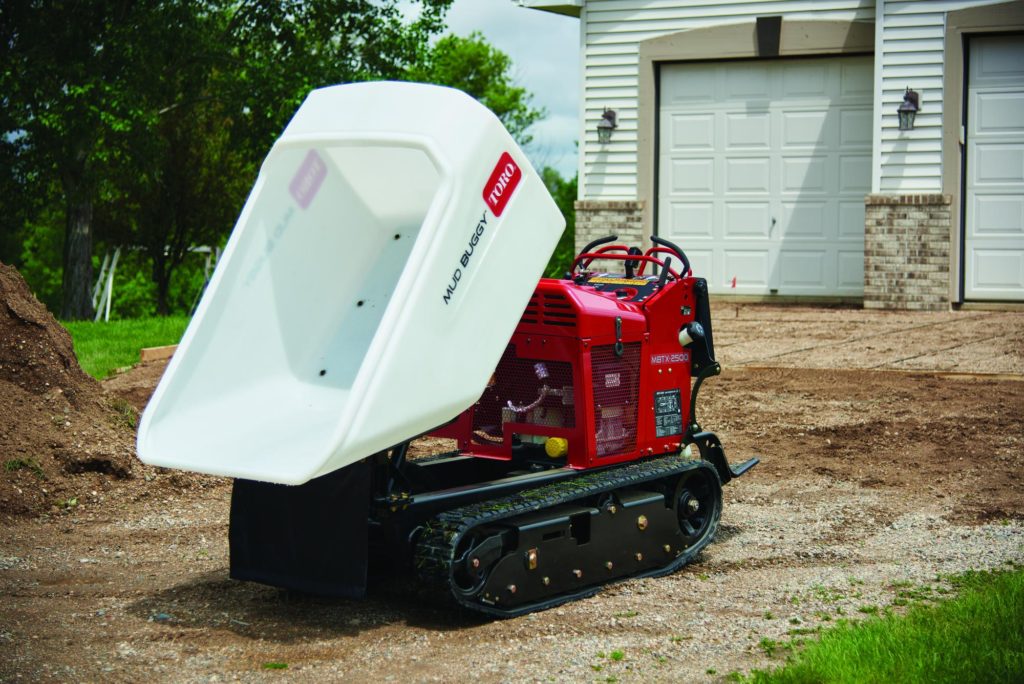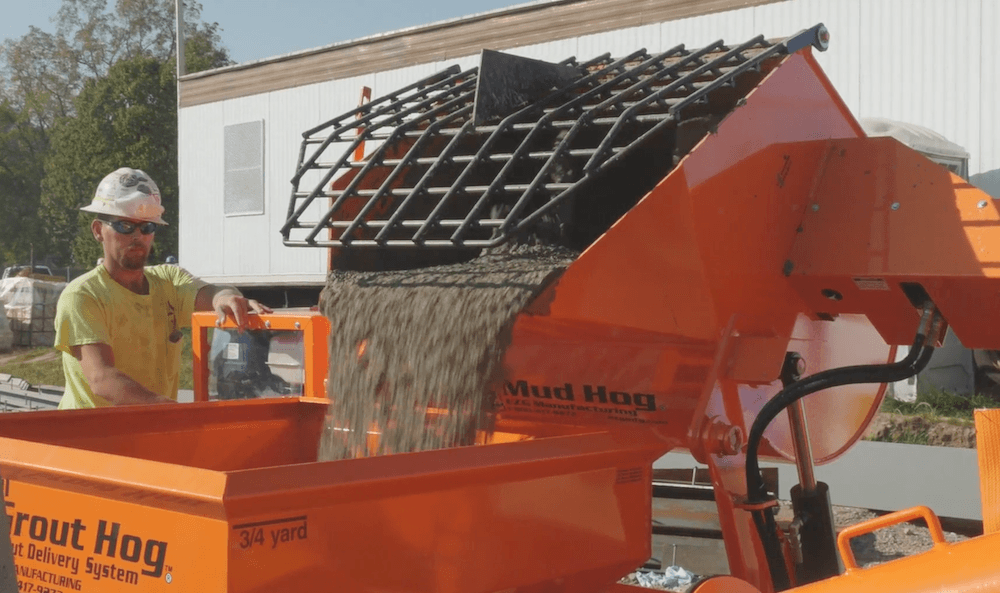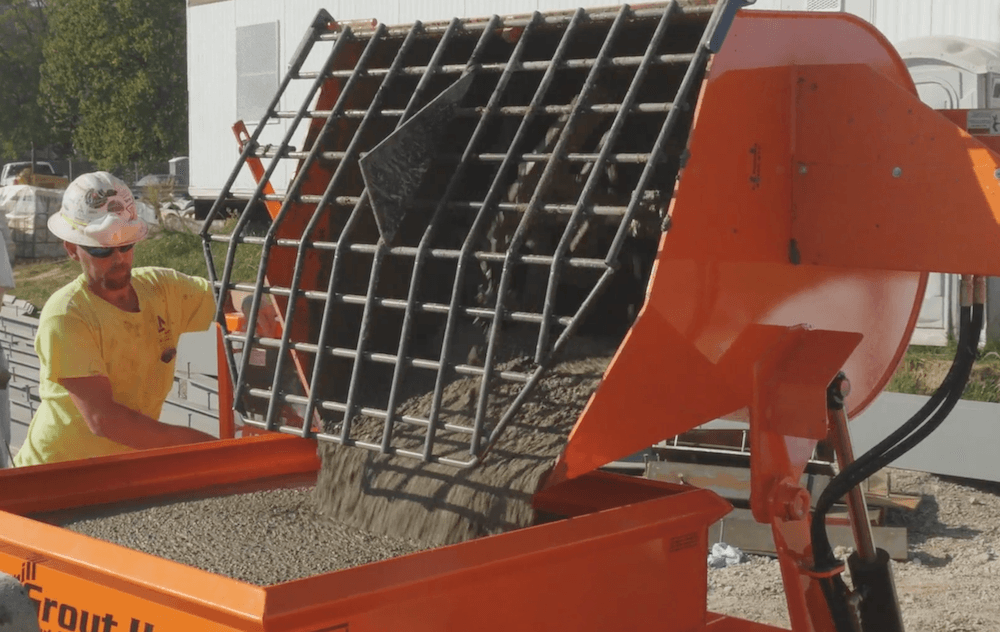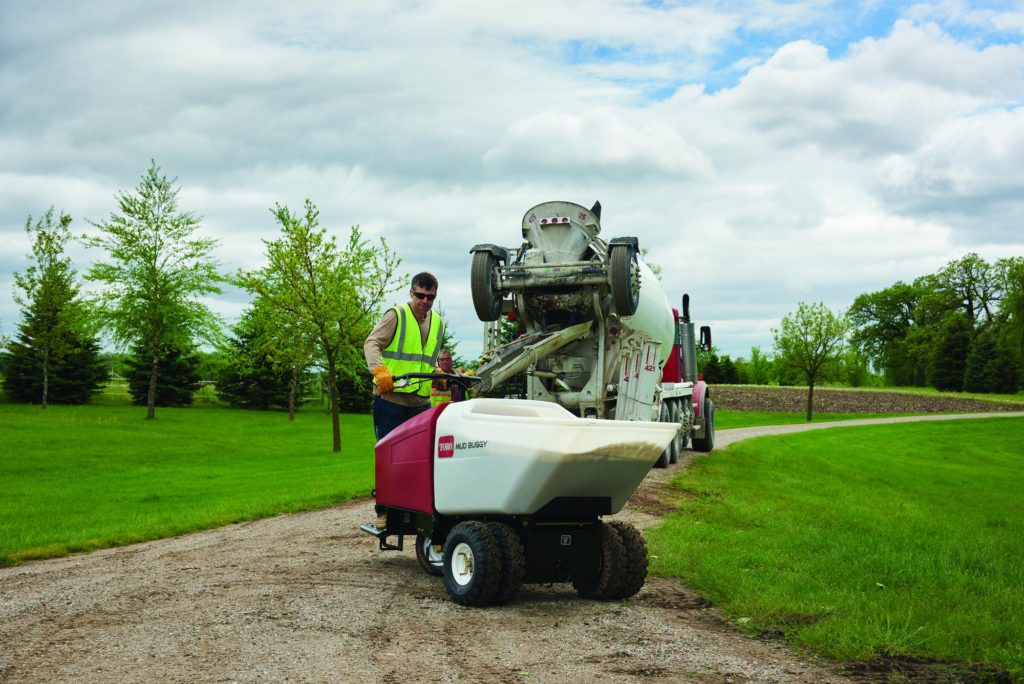Words: Sean O’Halloran, marketing manager at Toro
Photos: EZG Manufacturing, Toro
Hauling mud or concrete from point A to point B — this is a task that can be as simple or as complicated as the contractor wants to make it. It’s also where the right equipment can make a world of difference in terms of productivity and efficiency.
When considering equipment to help move material from one place to another, there are a number of equipment options at the contractor’s disposal, and factors like the type of material being moved, terrain on the jobsite, and quantity of material to be moved will help determine the proper equipment to use for each hauling or placement task.
A relatively new, rising star in terms of equipment for this kind of work is the powered concrete buggy – also known throughout the industry as the powered buggy or concrete buggy. Toro’s concrete buggy line goes by a different name – the Toro Mud Buggy® product family, but all are generally recognized as the same class of machine. This type of equipment was once considered to be a niche machine for concrete placement in remote areas, but contractors are now putting this equipment to work on a larger scale after realizing the inherent benefits of a workhorse like a concrete buggy on their jobsite. Being relatively simple-to-use machines with a simple, concrete buggies can help increase jobsite efficiency without a huge capital investment.
Concrete buggies also have inherent benefits over traditional material hauling methods like a wheelbarrow. For example, the equipment helps reduce worker strain and fatigue as every function from transport to dumping is effortless – potentially helping to contribute to a reduction in workplace injuries. Additionally, most concrete buggies on the market today feature impressive tub and hauling capacities, making them much more efficient than traditional hauling methods.
Making the Selection
Manufacturers like Toro, Canycom and Allen all provide concrete buggies to the construction, masonry, rental and landscaping markets. Some of these manufacturers, like Toro, offer both wheeled and tracked configurations. Contractors can make the right choice for their operation by considering how and where the machine will be most used. For example, if they’re planning on using this machine on a large-scale construction site with uneven and varied terrain, a tracked concrete buggy solution may be the right choice. Alternatively, contractors planning to use this machine on paved, relatively consistent surfaces may prefer a wheeled option, which is historically less expensive than their tracked counterparts. Also factoring into the consideration set should be capacity requirements based on their needs in a typical workday – in terms of both drive/dump power, as well as tub capacity. Toro offers two concrete buggy models – the MB TX 2500tracked Mud Buggy, and the MB-1600wheeled Mud Buggy – with different features engineered into each.
On the Right Track
When comparing the two concrete buggy configurations side-by-side, tracked concrete buggies have been the more popular option over the past few years as contractors begin to realize how versatile a solid tracked machine can prove to be on a jobsite. To put it plainly, these units can reach remote areas and handle terrain that their wheeled cousins cannot, so if a contractor is hoping to use the concrete buggy in soft soils, sand or uneven terrain, a tracked model brings obvious benefits to the table. In addition to looking at terrain type, tracked models also perform better than their wheeled counterparts in less than desirable conditions like extremely wet conditions or even snow and ice.
Concrete buggy manufacturers like Toro have integrated a lot of user-friendly features into their tracked concrete buggy models making these machines easier to use and more efficient than ever before. For instance, Toro’s MB TX 2500 tracked Mud Buggy offers intuitive controls resulting in excellent maneuverability in confined areas. The unit can carry up to 2,500 lbs. of material, which maximizes efficiency on site. Powered by a 25 hp Kohler Confidant engine, the tracked model can easily handle a wide range of hauling tasks. Additionally, the MB TX 2500 can reach transport speeds of up to 6 mph in forward and 3 mph in reverse to quickly and safely transport material around the jobsite. Toro’s tracked Mud Buggy also features an innovative dump switch that is linked to the movement of the traction control and always close to the operator’s thumb for easy access.
When looking into the integrity of the tracks, specifically, contractors need to be looking for two things – durability and productivity. Some manufacturers, like Toro, have invested substantial time and resources into research and development, making sure the tracks on tracked Mud Buggy models can handle the specific (and often major) demands of a construction site. Toro’s model features Kevlar reinforced tracks for maximum durability, and an aggressive tread to maximize productivity out in the field, regardless of terrain or conditions. One other feature that contractors may want to look at is the length of the tracks on the unit. Longer tracks provide additional stability and can help increase productivity on site.

Putting the Wheels in Motion
It’s no secret that tracked concrete buggy units have seen a boost in popularity in recent years, but there’s still an important spot in the marketplace for tried-and-true wheeled concrete buggy models. Although the Toro wheeled Mud Buggy unit boasts the same 2,500-pound hauling capacity as the tracked model, these units are typically used on smaller jobsites with hard surfaces. There are a few key benefits of a wheeled unit, and one of these is a lower up-front cost. This is one reason why it’s important for a contractor to really analyze what a normal day’s work for the concrete buggy will look like before purchasing the equipment. If the concrete buggy will be used on hard surfaces and smaller jobsites the majority of the time, it might not be in the contractor’s best interest to spring for a more expensive tracked model.
Not surprisingly, wheeled units also typically reach higher transport speeds than tracked concrete buggies, which can be a useful feature on expansive jobsites. Toro’s wheeled Mud Buggy, the MB-1600 can reach ground speeds of up to 7 mph for maximizing hauling productivity. Other features on this unit that will appeal to operators of all skill levels include simple controls for drive and dumping, the ability to ride-on or walk-behind the unit, and a fully hydraulic dump system that makes for smooth and effortless unloading.
Efficiency is Key
Whether a contractor selects a tracked or a wheeled unit, the key role of a concrete buggy is to increase productivity on the

Sidebar
Things Mason Contractors Should Know About Mixers
Words: MASONRY Magazine
Mixers and delivery systems are more than just a good investment for a mason contractor’s business, big or small. It can be the difference between efficiency on a jobsite and minimal productivity on a project. There are some key components you should take into consideration while in the market for a new mixer and delivery system, according to Steve Wheeler, Sales Representative of EZG Manfacturing.
- Thickness of the drum: Contractors mix grout or mortar daily, if the drum of the mixer is made with thin gage steel the paddles can wear holes in the drums within a few months. Which will lead to repairs that will be needed or having to replace the mixer.
- Quality of the paddle blades: Low quality paddles can wear out quicker, in as little as a month. Which can require these types of blades to be replaced or it can lead to the operators to manually clean the layer of mortar that is left inside the drum.
- How the engine has to be started: The way the mixer is started can be all the difference in efficiency on a
jobsite . If the engine has apull start , the operator has to pull on the cord each time to start the engine to mix the mortar or grout. Which can lead to the cord or engine wearing out at a quickerpace. However, if the engine is electric the battery gets recharged while the engine is running, the only time the operator would have to “cord start” the engine is in the case of the batterybeing dead.

Reversible paddles, waist-height mixers, and being able to mix both grout and mortar are additional components contractors should look out for in mixers before purchasing. This is an investment in your company or business and you want to be sure you won’t have to replace it before you can get a return on your investment.
